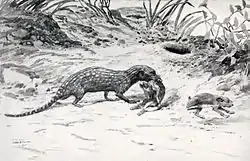Pachyrukhos
Pachyrukhos is an extinct genus of mammals from the Late Oligocene to Middle Miocene (Santacrucian-Friasian in the SALMA classification) of Argentina (Collón Curá, Sarmiento and Santa Cruz Formations) and Chile (Río Frías Formation), South America.[1]
| Pachyrukhos | |
|---|---|
 | |
| Restoration of Cladosictis lustratus attacking Pachyrukhos moyani | |
| Scientific classification | |
| Kingdom: | |
| Phylum: | |
| Class: | |
| Order: | |
| Suborder: | |
| Family: | |
| Genus: | †Pachyrukhos Ameghino 1885 |
| Species | |
| |
| Synonyms | |
| |
Description
It was about 30 centimetres (0.98 ft) long and closely resembled a rabbit, with a short tail and long hind feet. Pachyrukhos was probably also able to hop, and it had a rabbit-like skull with teeth adapted for eating nuts and tough plants. The complexity of its hearing apparatus in the skull suggests that its hearing would have been very good, and that it probably had large ears. It also had large eyes, suggesting that it may have been nocturnal. These similarities are the result of convergent evolution, since, while quite unrelated to modern rabbits, Pachyrukhos filled the same ecological niche.[2]
References
- Pachyrukhos at Fossilworks.org
- Palmer, D., ed. (1999). The Marshall Illustrated Encyclopedia of Dinosaurs and Prehistoric Animals. London: Marshall Editions. p. 251. ISBN 1-84028-152-9.
